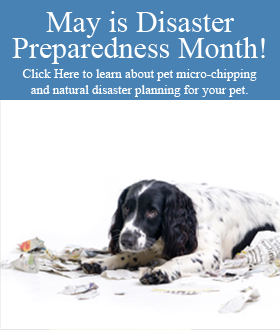In many parts of the country, sweltering temperatures routinely top 100 degrees, especially in our “Sunshine State.” People as well as animals get stressed from the heat and it’s important to make an extra effort to keep pets cool, comfortable and healthy. Dogs get lots of media attention during the summer, but cats and other creatures (including humans) are at risk too.
If and when an emergency occurs, this is not the time to be searching for your veterinarian’s phone number or the address of the nearest animal emergency clinic. Keep important numbers and up to date medical information for your pet in your wallet, car or in your phone at all times.
Get to know your pet (which most of us already do) so that you can recognize an emergency. Learn to take your pet’s pulse, count resting breaths and pants when exercising and ask your veterinarian how to take your pet’s temperature (or ask them when your pet is examined). Knowing what is normal for your pet will help you recognize an emergency soon enough to take action to minimize danger. Normal temperatures on cats and dogs are around 101 degrees. ANYTHING over 103 may be considered an emergency.
NEVER, NEVER, NEVER leave an animal in a parked are, even when it’s only 80 degrees outside. The inside of a car can heat up to more than 120 degrees in just minutes. Leaving the windows partially rolled down won’t do the trick. Even if you plan to be in the store for just a minute, your pet is at risk of a heat stroke.
Keep animals out of direct sunlight during the heat of the day, roughly 10 am to 6 pm. Dogs can only regulate their body temperature by panting and by a tiny amount of evaporation of sweat through the pads of their feet. When overheated, heatstroke can occur and lead to brain damage or death. Older, younger, overweight and snub-nosed breeds (such as bulldogs, pugs, shih tzus, etc.) can have an especially difficult time with the heat. Also, long-haired breeds may need a summer trim to keep cool. Just remember not to shave hair too close, creating a risk of sunburn and skin irritation.
Know the signs of heat stroke. Symptoms in dogs include excessive panting, drooling, rapid pulse, fever, behavior change and collapse. Immediately run cool (not ice cold) water over the animal and place cool towels on belly, armpits and neck before transporting your pet to the veterinarian. A fan helps also. Try offering your pet water, a little at a time, to re-hydrate. Panting in cats is not normal and can be a sign of distress.
Avoid strenuous exercise with your dog on extremely hot days and do not exercise during the intense mid-day heat. Remember that your dogs are eager to please and will keep going until you tell them to stop.
Always make sure animals have access to fresh water and shade. Try spraying down a favorite shaded area a few times during the day to create an outdoor “evaporative cooling system.” If your dog needs to be outdoors, try filling a kiddie pool with water and leaving it in the shade. Just change the water often to avoid attracting a new batch of mosquitoes.
Cats exhibit many of the same symptoms as dogs when stressed by the heat. Early signs of heat stroke can be panting, anxiety and pacing, increased heartbeat, respiratory distress or hyperventilation, lethargy and an increased body temperature. Oddly enough, cats affected by heat may actually drink less when they should be drinking more. Add ice cubes to their water bowl, or encourage your kitty to drink by dabbing a little water at the corner of his or her mouth.
A good rule of thumb is if you’re uncomfortable, your pet is uncomfortable.





































